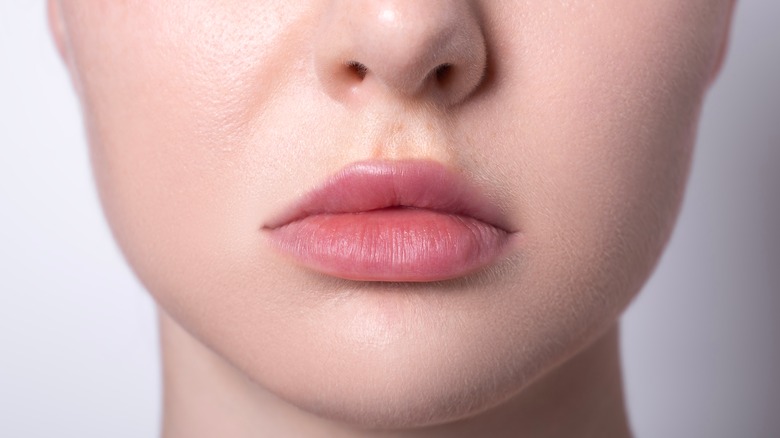Facial Balancing: What It Is And What It Can (& Can't) Do For You
Social media filters let us instantly transform the angles and contours of our faces, a fun time-waster that's in fact been subtly altering beauty ideals. Doing this in real life is a bit more challenging: face, eye, and neck lifts, or facial implants, are expensive surgeries that require significant recovery time and upkeep. If you're on a tight budget, what might sound more accessible is at-home face yoga — but facial exercises are limited in what they can (and can't) do to improve facial contours.
There is a middle ground, though, between major surgery and face yoga. An effective and affordable way to upgrade your appearance is facial balancing. Facial balancing is using injectable dermal fillers to create more facial symmetry, shift your face's proportions, and balance your features from the front and the side, all without surgery. The process involves strategically injecting filler to correct "imbalances" in the jawline, chin, cheekbones, and hairline areas.
Doctors employ a couple of beauty standards — if the forehead, nose, and chin each take up one-third of your face, that's considered an ideal proportion. Others use the Golden Ratio, which appears throughout the natural world in plants and seashells. Maningas Cosmetic Surgery's blog says "A visually balanced face is approximately 1.618 times longer than it is wide," using the Golden Ratio.
The pros of facial balancing
Compared to major surgery, fillers are much more affordable. RealSelf's Karyn Repinski compiled patient reviews stating that the average dermal filler costs $1,334, though it can be significantly lower or higher depending on what and how much is used. In contrast, the American Society of Plastic Surgeons says the average facelift costs $8,005. The average cost of cheek implants, as one example, is $3,669 and does not include operating room or anesthesia costs.
Other great advantages to facial balancing: getting fillers is a simple in-office procedure with none of the downtime that surgery requires, and the results are instantly visible. In the hands of an expert, fillers are very natural looking and are especially useful for contouring, creating symmetry, or balancing out facial proportions. Not only that, but if your doctor uses the right brand of filler and you run into a snag, the results can be immediately dissolved.
The best part of facial balancing? The treatment is totally customizable for your face, and most filler procedures last for a year to a year and a half. How fillers settle into your face in the future is well-known, but an alternative way to contour the lower face, buccal fat removal, is not — and it's much more difficult to reverse buccal fat removal down the road than facial balancing.
The cons of facial balancing
It's normal to get bruising and swelling in the days after your office visit. One possible result from the procedure: asymmetry, the exact opposite of what you're going for. Acne may be a side effect for some, as well as lumpiness or scarring.
"Plastic surgery is the wild west of medicine," cautions holistic plastic surgeon Anthony Youn, M.D. on his YouTube channel. "There are good plastic surgeons and dermatologists injecting patients safely. But there are also woefully trained doctors and non-doctors who don't know anatomy who are out there injecting patients." He shares that he uses hyaluronic acid-based fillers like products made with Restylane and Juvederm. If there's a problem, they can be dissolved using hyaluronidase, and he strongly advises patients to make sure their practitioners have hyaluronidase available on-site during the procedure. He also uses Sculptra and considers it a sufficiently safe filler.
Use Botox for forehead wrinkles or the glabella (between the eyebrows) and never dermal fillers because, he says, "If you have filler inappropriately injected into that area, people have actually gone blind from it." One of the dangers of so-called permanent fillers, those that aren't hyaluronic acid-based, is that if they're accidentally injected into a blood vessel, "people get horrible scarring from fillers or [lose] parts of their nose." Yikes.
How to prepare for facial balancing
When it comes to facial balancing, don't get seduced by abnormally low prices; do some online research, get personal referrals if you can, and pick your licensed practitioner wisely. Book an appointment to consult with the plastic surgeon, dermatologist, or practitioner first. As with anyone assisting you with an intimate, personal transformation (therapists, medical doctors, and energy healers), use the consultation not only to discuss what procedures you'd like done but to determine whether or not you feel comfortable with this person. Choose accordingly.
Board-certified dermatologist, Dr. Jesse Cheung shared with Elle some best practices to prep for your session including avoiding saunas, all pain relievers, vitamin E, ginkgo, fish oil, and intense cardio the week before your appointment. She added it's best to abstain from alcohol three days before and after your session to offset swelling.
Plastic surgeon Joshua Zimm, M.D. adds you should also avoid taking St. John's Wort and garlic pills before your visit. Also, avoid tweezing or other hair removal methods as well as consuming excessively salty foods in the few days before. He also advises taking an oral dose of the natural anti-inflammatory remedy arnica montana pre-procedure. Discuss if you're immunosuppressed with your doctor, and injectables are not recommended for women who are pregnant or breastfeeding.



